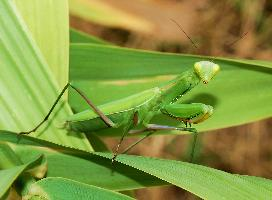
Popis zvířete
The European mantis, scientifically known as Mantis religiosa, is a captivating insect that belongs to the family Mantidae. This species, which is one of the most widely recognized mantids, is notable for its distinctive appearance and fascinating behaviors. Mantis religiosa has a widespread distribution across Europe, Asia, and even parts of North America, where it has been introduced. Its adaptability to various habitats, including grasslands, meadows, and gardens, has contributed to its widespread presence.Adult European mantises typically reach a length of about 7 to 8 centimeters, with females generally being larger than males. Their bodies are slender and elongated, displaying a vibrant green or sometimes brown coloration, which serves as excellent camouflage in their natural vegetative environments. This camouflage is crucial for their survival, as it allows them to blend seamlessly with leaves and stems, making them nearly invisible to both predators and prey.
One of the most distinctive features of the European mantis is its "praying" posture, from which its common name is derived. This posture is characterized by its forearms folded upwards, a stance it assumes while waiting to ambush its prey. These forearms are equipped with sharp spines, enabling the mantis to grasp and hold onto its prey securely.
The European mantis is a formidable predator, feeding on a wide variety of insects such as flies, crickets, and even other mantids. Its hunting technique is both patient and precise; it remains motionless, blending into its surroundings until an unsuspecting prey comes within reach. Then, with lightning-fast reflexes, it strikes, capturing the prey with its powerful forelegs.
Reproduction in Mantis religiosa follows a fascinating, if somewhat macabre, ritual that often includes sexual cannibalism. After mating, the female sometimes eats the male, a behavior thought to provide the female with the necessary nutrients for egg production. The female lays her eggs in a foam-like substance that hardens to protect the eggs through winter, ensuring the next generation's emergence in spring.
The lifecycle of the European mantis, from egg to adult, encompasses several molts, during which it sheds its exoskeleton to grow. This process, known as ecdysis, is a critical phase of its development. Nymphs (young mantids) resemble adults but lack fully developed wings. With each molt, they grow larger and gradually develop their adult form.
The European mantis, aside from its ecological role as a predator controlling pest populations, has captured human interest throughout history. It has been a subject of fascination, reverence, and even inspiration in various cultures, admired for its graceful yet deadly hunting prowess and its seemingly contemplative stance. In some regions, it is even considered a symbol of patience and mindfulness.
In summary, the European mantis (Mantis religiosa) is an extraordinary insect, embodying the delicate balance between beauty and predation. Its remarkable adaptability, intriguing behaviors, and ecological significance make it a key player in the biodiversity of the regions it inhabits.
Nové fotografie zvířat
Top 10 zvířat
- Diana monkey (Cercopithecus diana)
- Dolphin gull (Leucophaeus scoresbii)
- Galápagos tortoise (Geochelone nigra complex)
- Moustached guenon (Cercopithecus cephus)
- Japanese spider crab (Macrocheira kaempferi)
- Stone loach (Barbatula barbatula)
- Colossal squid (Mesonychoteuthis hamiltoni)
- Common house mosquito (Culex pipiens)
- Common reed warbler (Acrocephalus scirpaceus)
- Sea urchins (Echinoidea)